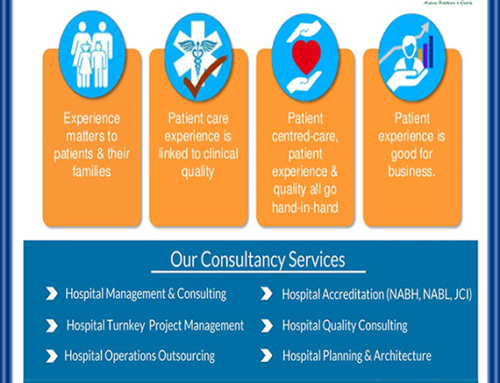The most common question hospitals ask today is, “Why do we need to get NABH accredited apart from the fact that the deadline for its implementation is approaching soon?”
CURRENT SCENARIO
Did you know? According to World Health Statistics, India has 0.9 beds per 1000 population, way below the global average of 2.9?
Since the last few years, the healthcare industry witnessed a lot of capital inflow especially by private sector into building new hospitals. But only metros and a few tier-I cities have gained from this as most of the infrastructure is built here. Because of this the hospitals are unevenly distributed all over the country. This has also lead to over-penetration in many areas. Thus, today hospitals are fighting tooth and nail with their peers to achieve moderate bed occupancy. But the question here is, how can NABH help us overcome this dilemma?
NABH FOR SUSTAINABLE COMPETITIVE ADVANTAGE

National Accreditation Board for Hospitals and Healthcare Providers (NABH) was established in 2006 and has gained prominence only in the past few years. The idea was to reduce the disparity between what the patients demanded and what the hospitals were offering. In its latest revision (4th edition) the NABH standards for hospitals is spread over 105 standards with 683 objective elements. Till date only 519 hospitals in India have been able to achieve accreditation from NABH. This is because the process for accreditation is very stringent. It requires the hospitals to demonstrate its compliance to standards. Only after a rigorous examination and assessment are the hospitals provided with the accreditation status. But once the hospitals are recognized as NABH accredited, they immediately gain immense significance and also enjoy a sustainable competitive advantage.
DEMANDED BY PATIENTS

Unlike in the west, most hospitals in India give preference to cost cutting and saving money and compromise on patient safety. In their defense, the healthcare industry blames it on the high rate of attrition and huge demand pressures leading to compromises on quality of medical professionals. Ultimately, it is the patients who have to succumb to all these issues.
However, there has been a paradigm shift in how patients today consume healthcare services. In the internet age, patients are using social media to voice their opinions. The present day patients question the treatment options offered to them by their doctors. Even so, many of them switch doctors easily if they are not satisfied. The modern day patients demand clinical excellence which is measurable and comparable. Check out our post on How to create patient-friendly hospital using NABH guidelines? to increase your quality of care and patient safety.
TAKE YOUR HOSPITAL TO THE NEXT LEVEL WITH NABH

In the evolving landscape of healthcare, the introduction of NABH standards stands as a pivotal step towards fostering global best practices. This accreditation mandates a profound shift in the institutional culture, necessitating the adoption of new policies to align with the prescribed standards. Hospitals pursuing NABH accreditation find themselves compelled to adhere to meticulous guidelines and rigorously measure their performance against predefined quality indicators.
Recently, patients have awakened to the significance of accreditation, influencing their choices when it comes to healthcare institutions. No longer solely focused on impressive infrastructure, skilled medical practitioners, and reasonable pricing, patients now prioritize accreditation as a crucial factor in their decision-making process. This shift in health trends underscores the growing concern among patients for the quality of care they receive, surpassing considerations of treatment costs.
In the years to come, accreditation bodies like NABH, NABL AND JCI will play a vital role in ensuring delivery of quality care in patient treatment. Since not even 1% of hospitals in India have received accreditation, this situation presents an opportunity for healthcare businesses to establish sustainable leadership position for themselves.







Leave A Comment